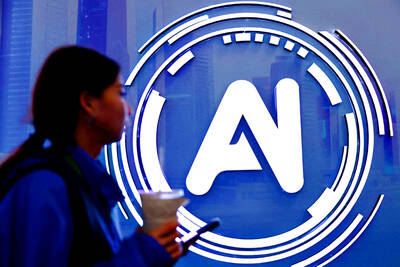Taiwan Semiconductor Manufacturing Co (TSMC, 台積電) is in early talks with the German government about potentially establishing a plant in the country, a senior executive said on Saturday.
Various factors, including government subsidies, customer demand and the talent pool, would influence its final decision, TSMC senior vice president of Europe and Asia sales Lora Ho (何麗梅) told reporters on the sidelines of a technology forum in Taipei.
The discussions come as the EU and others seek to increase domestic chip production to mitigate the risk of supply chain disruptions.

Photo: Ann Wang, Reuters
The chipmaker has not discussed incentives with Berlin or decided on a location, Ho said.
TSMC chairman Mark Liu (劉德音) in June told shareholders that the Hsinchu-based company had begun assessments on setting up manufacturing operations in the European country.
The world’s largest contract chipmaker, which mostly produces domestically, has started to diversify over the past year to help meet demand in various major countries seeking to bolster domestic semiconductor production out of national security and self-sufficiency concerns.
It is building a US$12 billion facility in Arizona, and is set to soon start construction of a US$7 billion plant in Japan.
Meanwhile, the EU said it would unveil the “European Chips Act” in the first half of next year as part of its strategy to boost semiconductor production.
One of the goals would be to account for 20 percent of global production by 2030, the bloc said.
Separately, research teams at Intel Corp on Saturday unveiled work that the US company believes would help it keep speeding up and shrinking computing chips over the next 10 years, with several technologies aimed at stacking parts of chips on top of each other.
Intel’s Research Components Group introduced the work in papers at an international conference held in San Francisco.
The company is working to regain a lead in making the smallest, fastest chips that it has lost in the past few years to rivals like TSMC and Samsung Electronics Co.
The newly unveiled research gives a look into how Intel plans to compete beyond 2025.
One of the ways Intel is packing more computing power into chips by stacking up “tiles” or “chiplets” in three dimensions rather than making horizontally designed chips, it said.
Intel showed work that could allow for 10 times as many connections between stacked tiles, meaning that more complex tiles can be stacked on top of one another.
However, perhaps the biggest advance showed at the event was a research paper demonstrating a way to stack transistors — tiny switches that form the most basic building blocks of chips by representing the ones and zeros of digital logic — on top of one another.
Intel believes the technology would yield a 30 to 50 percent increase in the number of transistors it can pack into a given area on a chip.
Raising the number of transistors is the main reason chips have consistently gotten faster over the past 50 years.
“By stacking the devices directly on top of each other, we’re clearly saving area,” Intel Components Research Group director Paul Fischer said. “We’re reducing interconnect lengths and really saving energy, making this not only more cost efficient, but also better performing.”

CHIP RACE: Three years of overbroad export controls drove foreign competitors to pursue their own AI chips, and ‘cost US taxpayers billions of dollars,’ Nvidia said China has figured out the US strategy for allowing it to buy Nvidia Corp’s H200s and is rejecting the artificial intelligence (AI) chip in favor of domestically developed semiconductors, White House AI adviser David Sacks said, citing news reports. US President Donald Trump on Monday said that he would allow shipments of Nvidia’s H200 chips to China, part of an administration effort backed by Sacks to challenge Chinese tech champions such as Huawei Technologies Co (華為) by bringing US competition to their home market. On Friday, Sacks signaled that he was uncertain about whether that approach would work. “They’re rejecting our chips,” Sacks

It is challenging to build infrastructure in much of Europe. Constrained budgets and polarized politics tend to undermine long-term projects, forcing officials to react to emergencies rather than plan for the future. Not in Austria. Today, the country is to officially open its Koralmbahn tunnel, the 5.9 billion euro (US$6.9 billion) centerpiece of a groundbreaking new railway that will eventually run from Poland’s Baltic coast to the Adriatic Sea, transforming travel within Austria and positioning the Alpine nation at the forefront of logistics in Europe. “It is Austria’s biggest socio-economic experiment in over a century,” said Eric Kirschner, an economist at Graz-based Joanneum

BUBBLE? Only a handful of companies are seeing rapid revenue growth and higher valuations, and it is not enough to call the AI trend a transformation, an analyst said Artificial intelligence (AI) is entering a more challenging phase next year as companies move beyond experimentation and begin demanding clear financial returns from a technology that has delivered big gains to only a small group of early adopters, PricewaterhouseCoopers (PwC) Taiwan said yesterday. Most organizations have been able to justify AI investments through cost recovery or modest efficiency gains, but few have achieved meaningful revenue growth or long-term competitive advantage, the consultancy said in its 2026 AI Business Predictions report. This growing performance gap is forcing executives to reconsider how AI is deployed across their organizations, it said. “Many companies

France is developing domestic production of electric vehicle (EV) batteries with an eye on industrial independence, but Asian experts are proving key in launching operations. In the Verkor factory outside the northern city of Dunkirk, which was inaugurated on Thursday, foreign specialists, notably from South Korea and Malaysia, are training the local staff. Verkor is the third battery gigafactory to open in northern France in a region that has become known as “Battery Valley.” At the Automotive Energy Supply Corp (AESC) factory near the city of Douai, where production has been under way for several months, Chinese engineers and technicians supervise French recruits. “They